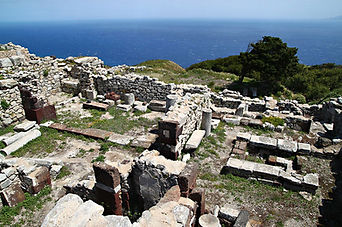About Santorini
Santorini is a volcanic island in the Cyclades group of the Greekislands. It is located between Ios and Anafi islands. It is famous for dramatic views, stunning sunsets , the unusual white houses perched high on the Calders walls, the town of Thira and naturally its very own active volcano. There are fantastic beaches such as the beach of Perissa, the black pebble beach of Kamari, white beach and red beach.
The two small islands in the centre of the Santorini caldera, Palea Kameni and Nea Kameni, “the volcano” according to the locals, are the youngest volcanic lands in the Eastern Mediterranean.
Palea Kameni (Old Burnt Island) is less than 2.000 years old, while Nea Kameni (Young Burnt Island) began to form only 440 years ago and its youngest lavas are only 60 years old. These two small islands are the result of the volcano’s most recent activity.
The Volcano's of Santorini



The wine of Santorini
In its early geological history, Santorini was the core of an ancient volcano that erupted in about 1640–1620 BC. A large part of the island became submerged, creating the modern day archipelago. Wine was made on the island in Greek and Roman times, but the region became particularly noteworthy in the Middle Ages when Crusaders captured control of the island from the Byzantine empire after Constantinople was sacked in 1203. One of the crusaders was a Venetian nobleman whose family maintained control of the island until 1336 when it became part of the Venetian maritime state Duchy of Naxos.
Under the Venetian influence, with this extensive trade network and maritime control, Santorini wines were widely exported throughout the Mediterranean and Europe. The wine was particularly prized for its ability to withstand the month long sea voyages due, in part, to its sweetness and high alcohol levels. So highly valued was Santorini wines during this period that when the Ottoman Turks captured the region in 1579, they still permitted the uninterrupted trade of the wine even though the religious edicts of their Muslim faith generally forbids alcohol. One explanation for the Turks concession was that the poor soil and perilous topography of the island, with cliffs running right to the sea, made the cultivation of other cash crops difficult. When the Russian Orthodox Church adopted Santorini wine as the official Eucharistic wine of the church, the Ottomans allowed the island producers to trade freely with Russia even during the frequent wars between the two empires.


Ancient Santorini.
Ancient Thera is an antique city on a ridge of the steep, 360 m high Messavouno mountain. It was named after the mythical ruler of the island, Theras, and was inhabited from the 9th century BC until 726 AD.
Ancient Thera is today open to the public and can be reached on a winding road that starts at Kamari or several foot paths from both sides of the mountain.



The prehistoric city of Akrotiri is a Minoan Bronze Age settlementin on the outskirts of the village of Akrotiri & is a must to see. The settlement was destroyed in the Theran eruption about 1627 BCE and was buried in volcanic ash, which preserved the remains of fine Frescoes and many objects and artworks. The settlement has been suggested as a possible inspiration for Plato's story of Atlantis. The site has been excavated since 1967.



Dining Out
Santorini’s cuisine is mainly based on the island’s agricultural products. Products nourished by the volcanic soil, the sea breeze and the sunlight of the Aegean Sea. These products have a unique taste. They provide us with top quality ingredients for cooking our original, tasty and healthy food.


The famous Santorini cherry tomato is a unique variety of tomato thats flavour is thanks to the arid volcanic soil that dominates the island. Used mainly in the islands greek salad it is also used to make a rich, delicious Tomato paste and tomato balls called "Tomatokeftedes" (a traditional dish of Santorini) and is a taste not to be missed.


Fava-Split peas
Santorini split peas or Fava, have also a distinctive delicate tasteas on their own, they have a soft earthy aroma and they are one of the most popular dishes in Santorini homes. You will find them in many different recipes, along with onion, with small pieces of pork, with aubergines and tomatoes, as well as in the form of soup.
White Eggplant
Another rare product of the Santorini soil with many comparative advantages. It has very few seeds, does not absorb much oil when fried and has a particularly sweet taste. So sweet that there is no need to de-bitter it at all. You will find white eggplant dishes at various restaurants on the island. It is really worth trying ‘melitzanosalata’ (white eggplant paste)!





Santorini Capers
The salted and pickled caper bud is often used as a seasoning or garnish. Capers are a common ingredient in Santorinian cooking. The mature fruit of the caper shrub are also prepared similarly, and marketed as caper berries. The buds, when ready to pick, are a dark olive green and about the size of a fresh kernel of corn. They are commonly used in salads, pasta salads, meat dishes and pasta sauces. Caper leaves, which are hard to find outside of Santorini, are used particularly in salads and fish dishes. They are pickled or boiled and preserved in jars with brine—like caper buds.
Santorini Katsouni
Katsouni is the name for Santorini’s cucumber. This refreshing vegitable cannot be found anywhere else. Smaller and with quite refreshing taste it is easy to find and taste it in Santorini or Greek Salad in restaurants across the island that specialise in local Greek cooking.

